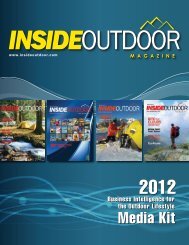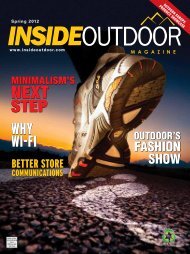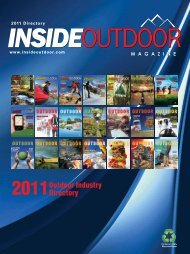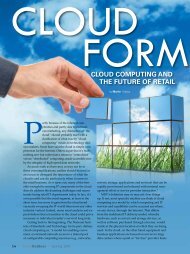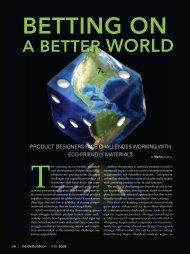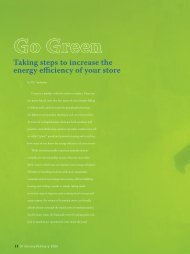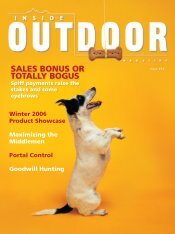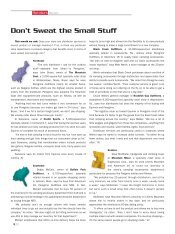Summer - InsideOutdoor Magazine
Summer - InsideOutdoor Magazine
Summer - InsideOutdoor Magazine
You also want an ePaper? Increase the reach of your titles
YUMPU automatically turns print PDFs into web optimized ePapers that Google loves.
Back Office<br />
Life Cycle Assessment Meets Web 2.0<br />
by Greg Norris<br />
IT IS HARD TO BE AWAKE THESE DAYS and not feel the<br />
change. People, lots more people, are taking a whole new<br />
look at their relationship with the planet. There are explosive<br />
new levels of concern about climate change and a rising<br />
sense that all of us need to play a role in addressing it. Mainstream<br />
Americans are starting to think and ask and care about<br />
our own “climate footprint,” about our impacts. We are taking<br />
it personally.<br />
Of course, when consumers and employees take our footprint<br />
impacts seriously, our employers and would-be vendors find<br />
they must do the same. This too is happening. These changes are<br />
accelerating, and it appears possible that they will coalesce into<br />
something planet-transforming — as they need to.<br />
THE STORIES BEHIND PRODUCTS<br />
This morning you probably showered and ate breakfast, and<br />
perhaps traveled to work, probably in a car. Even if you telecommute,<br />
look around your home office at the goods, powered by<br />
electricity, and at the furniture on which they all sit, as well as<br />
where you sit.<br />
Think about the supply chains for those products — the<br />
factories in Asia which produced your computer and printer,<br />
the power plants in your region that generate your electricity,<br />
the paper mills in North America that made your printer’s<br />
paper, the factories that produced the trucks that shipped your<br />
office supplies, and even the growers in South America who<br />
grew your coffee.<br />
Mainstream attention to climate change is helping mainstream<br />
folks think increasingly in terms of “footprints” and<br />
“embodied environmental burdens.” We are realizing that everything<br />
we buy has a story behind it.<br />
This thinking helps us realize that the influence of those<br />
purchases extends way beyond the final producers of goods<br />
and services. Many of the most important social and environmental<br />
impacts occur farther up the supply chain, often<br />
in countries beyond our borders. For some products, major<br />
impacts occur during the usage phase and/or disposal phase<br />
of the life cycle as well.<br />
In the late 1960s, folks in the United States and Europe<br />
began asking themselves about such stories behind the life<br />
cycles of beverage containers. They noticed a shift underway,<br />
from returnable bottles to “one-way” (disposable) packaging,<br />
and wondered what the shift might mean for issues like energy<br />
use, solid waste and pollution.<br />
In an attempt to provide quantitative comparisons of the environmental<br />
“stories” of different packaging alternatives, the<br />
method of “Life Cycle Assessment” was born.<br />
LIFE CYCLE ASSESSMENT<br />
Life Cycle Assessment (LCA) is now an ISO standardized<br />
approach for quantitatively summarizing environmental impacts<br />
over product supply chains and life cycles. The range of<br />
environmental concerns addressed by LCA is designed to be<br />
comprehensive, including impacts on human health, ecosystems,<br />
climate, and resources.<br />
LCA addresses impacts attributable to emissions to air,<br />
water and soil, as well as extractive flows from the environment.<br />
More recently, LCA is being expanded to address social<br />
issues in supply chains and life cycles as well.<br />
Today’s LCAs are done primarily by and for large organizations.<br />
This is because LCA requires extensive databases and<br />
the use of specialized modeling software. The databases are<br />
comprehensive, containing data on thousands of interconnected<br />
unit processes, with each process using specified<br />
quantities of inputs from nature and other unit processes, and<br />
most also emitting specified quantities of many different pollutants<br />
to air, water, and land.<br />
These comprehensive databases require millions of dollars<br />
and many years to create, and they must then be kept current.<br />
The Swiss government, for example, has invested the required<br />
resources during the past 30 years to achieve today’s “EcoInvent”<br />
database (www.ecoinvent.ch). In addition, U.S. agencies<br />
have partnered with private industry to launch the U.S. LCI database<br />
(www.nrel.gov/lci), although after five years the database<br />
contains a few hundred processes.<br />
The standard approach to LCA database development has<br />
followed the standard model of Web database creation, namely<br />
a centralized, provider-driven effort. The creator of an LCA database<br />
sends detailed questionnaires to a representative sample<br />
of companies that produce a particular product of interest. This<br />
research institute or consulting firm gathers and aggregates the<br />
data from the different companies, performs important quality<br />
assurance and error checking, and generates data on the average<br />
production of the product.<br />
Web 2.0, the paradigm of “bottom-up,” user-driven content<br />
development, illustrates a whole different approach to<br />
LCA data development and use. As in other areas of information<br />
creation and sharing, the shift from provider-driven data<br />
to user-created data has the potential to create vastly richer<br />
data resources while also democratizing access to, and use<br />
of, the information.<br />
The data sources for LCA can be richer in at least two key<br />
ways. First, they can cover a much wider fraction of the goods<br />
and services sold in the economy, and second, they can be<br />
brand specific.<br />
70 | <strong>InsideOutdoor</strong> | <strong>Summer</strong> 2007




